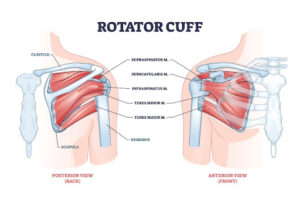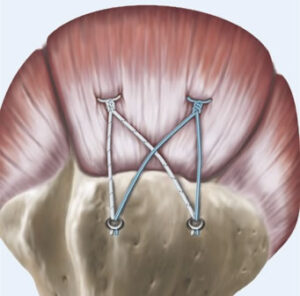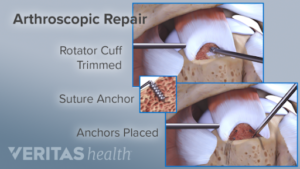Have you ever experienced a sudden, sharp pain in your shoulder while reaching for something on a high shelf or attempting a simple throwing motion? If so, you’re not alone. Rotator cuff injuries, like a torn rotator cuff or shoulder tendon tear, are more common than you might think. In fact, they affect millions of people worldwide, impacting their ability to perform everyday tasks and enjoy an active lifestyle.
Understanding the intricacies of rotator cuff injuries is not only crucial for your well-being but also for effectively managing and recovering from them. Whether you’re an athlete, a weekend warrior, or someone who simply values the freedom of pain-free movement, grasping the fundamentals of rotator cuff injuries is the first step towards regaining control over your shoulder health.
In this article, we’ll simply the complex anatomy of the shoulder, explore the different types of rotator cuff injuries, and discover the best treatment and management strategies for a swift recovery. So, let’s embark on this journey together and pave the way to a healthier, stronger you.
Anatomy of The Rotator Cuff
At the heart of your shoulder’s intricate anatomy lies an important structure known as the rotator cuff. Comprised of tendons and muscles, this vital network plays a pivotal role in maintaining the mobility and stability of your shoulder joint. Central to this functionality are the four key rotator cuff muscles, all of which serve important functions that ensure seamless shoulder movement.

The Supraspinatus: Initiating Shoulder Abduction
The supraspinatus muscle, one of the key components of the rotator cuff, plays a crucial role in initiating shoulder abduction. When you raise your arm sideways, the supraspinatus activates, allowing for smooth and controlled movement. It acts as a stabiliser, preventing the humeral head (the ball-shaped part of the upper arm bone) from impinging on the surrounding structures within the shoulder joint.
The Infraspinatus and Teres Minor: Enabling External Rotation
Working in harmony, the infraspinatus and teres minor muscles contribute to the external rotation of the shoulder. External rotation is the movement that allows you to rotate your arm outward, such as when you’re throwing a ball or reaching for something behind you. These muscles provide strength and stability to the shoulder joint, allowing for controlled movement and preventing excessive stress on the surrounding structures.
The Subscapularis: Assisting Internal Rotation
The subscapularis muscle, located at the front of the shoulder, is responsible for internal rotation. This movement allows you to rotate your arm inward, such as when you’re reaching for your back pocket or fastening your bra. The subscapularis works in tandem with the other rotator cuff muscles to maintain balance and control during various shoulder movements, ensuring the optimal functionality of the joint.
Identifying The Types of Rotator Cuff Injuries
Despite its great resilience, the rotator cuff is susceptible to injury, especially with repetitive overuse or traumatic events. Understanding the different types of rotator cuff injuries can help you recognise and address them promptly. Let’s explore the most common types of injuries and their distinguishing characteristics.
Rotator Cuff Tear: When Fibers Fray
A rotator cuff tear occurs when one or more of the tendons in the rotator cuff become partially or completely torn. This injury can result from acute trauma, such as a fall or lifting a heavy object, or from chronic wear and tear over time. Symptoms of a rotator cuff tear may include a deep, aching pain in the shoulder, weakness, limited range of motion, and difficulty performing overhead activities. If you experience persistent discomfort or have difficulty raising your arm, it’s important to consult a shoulder health specialist who can provide an accurate diagnosis and recommend appropriate treatment options.

Shoulder Tendon Tear
A shoulder tendon tear refers to the tearing or detachment of a specific tendon within the rotator cuff. Similar to a rotator cuff tear, this injury can be caused by sudden trauma or gradual degeneration. The symptoms of a shoulder tendon tear are comparable to those of a rotator cuff tear and may include pain, weakness, and restricted movement. Identifying the specific tendon affected can help your treatment team tailor their approach to address the injury effectively.
Torn Rotator Cuff Symptoms
When dealing with a torn rotator cuff, symptoms can vary in intensity and manifestation. The most common indicators include persistent shoulder pain, particularly when lifting or reaching overhead, weakness in the affected arm, a noticeable decrease in shoulder mobility, and a clicking or popping sensation during certain movements. It’s essential to note that not all torn rotator cuff cases display the same symptoms, making a thorough examination crucial for an accurate diagnosis.
Tear vs. Strain: Understanding the Difference
It’s important to differentiate between a tear and a strain when it comes to rotator cuff injuries. While a tear involves a partial or complete rupture of the tendons, a strain refers to overstretched or pulled muscles or tendons without tearing. Strains are often characterised by localised pain, tenderness, and limited range of motion. Although less severe than a tear, a strain can still cause discomfort and hinder shoulder function. Both tears and strains require proper diagnosis and appropriate treatment to ensure optimal recovery.
Treatment and Management of Rotator Cuff Injuries:
When it comes to treating a rotator cuff tear, there are several options available, depending on the severity of the injury and individual circumstances. Conservative approaches, such as rest, ice, and nonsteroidal anti-inflammatory drugs (NSAIDs), may be recommended for mild cases. Physical therapy, focusing on strengthening the surrounding muscles and improving your range of motion, can be an integral part of recovery. In more severe cases, surgical interventions, such as arthroscopic or open repair, may be necessary to reattach or repair the torn tendon. Consulting with a shoulder specialist will help determine the most suitable treatment approach for your specific rotator cuff tear.

The Importance of Physical Therapy and Rehabilitation
Physical therapy and rehabilitation play a pivotal role in the recovery process for rotator cuff injuries. These interventions focus on restoring functionality, improving strength and flexibility, and enhancing overall shoulder stability. A qualified physical therapist will guide you through targeted exercises and techniques to gradually rebuild the strength of the rotator cuff and surrounding muscles. They will also provide education on proper posture, body mechanics, and techniques to prevent further injury. Engaging in a comprehensive rehabilitation program can significantly improve your chances of regaining full shoulder function and minimizing the risk of future injuries.
Tips on Preventing Future Injuries
Prevention is always better than cure when it comes to rotator cuff injuries. Here are some essential tips to protect your shoulder health and reduce the likelihood of future injuries:
Warm-Up and Stretch
Prior to engaging in any physical activity, warm-up exercises and proper stretching routines are crucial to prepare your muscles and tendons for movement.
Maintain Good Posture
Practice proper posture, especially when sitting for extended periods or performing repetitive tasks. A neutral spine and aligned shoulders reduce unnecessary stress on the rotator cuff.
Use Proper Lifting Techniques
When lifting heavy objects, ensure you use your legs and core muscles rather than relying solely on your shoulders. Distribute the weight evenly and avoid sudden jerky movements.
Gradual Progression
Whether in sports or exercise, gradually increase the intensity and duration of your activities. Sudden spikes in intensity can strain the rotator cuff.
Take Charge of Your Shoulder Health Today!
Rotator cuff injuries can be painful and restrictive, but with the right treatment and management strategies, individuals can find relief and regain optimal shoulder function. Exploring various rotator cuff tear treatment options is essential, ranging from conservative approaches like rest and physical therapy to surgical interventions for severe cases. Physical therapy and rehabilitation play a crucial role in the recovery process, helping to restore strength, flexibility, and stability to the shoulder.
Don’t hesitate to get in touch with Dr Stuart Kirkham at the Sydney Orthopaedic Surgeon Clinic if you are struggling with a rotator cuff injury and need assistance. With his expertise, he can guide you towards achieving relief and enhancing your overall well-being.


